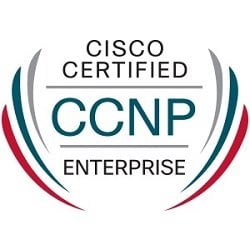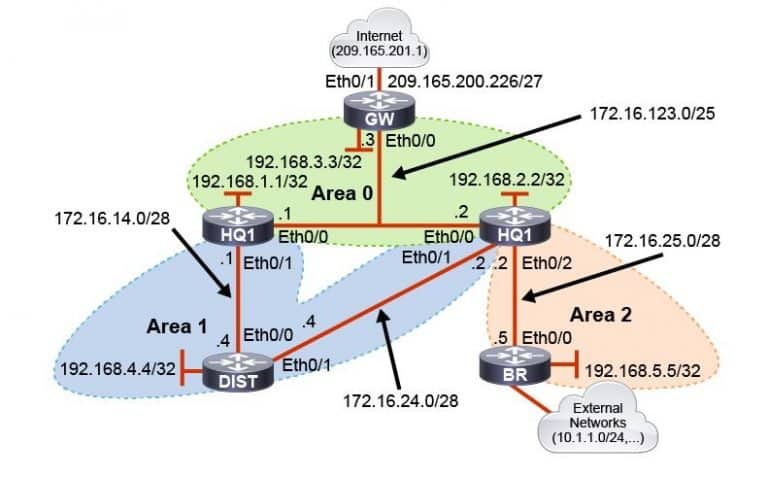Obiettivi | Certificazione | Contenuti | Tipologia | Prerequisiti | Durata e Frequenza | Docenti | Modalità di Iscrizione | Calendario

Il Corso ENCOR Implementing Cisco Enterprise Network Core Technologies è il pilastro fondamentale del percorso tecnologico Cisco Enterprise. Durante il corso, i partecipanti approfondiranno le architetture di rete, i protocolli di routing come OSPF, EIGRP e BGP, e la gestione di reti IP e IPv6. Verranno trattate tecnologie di switching come VLAN, STP, MSTP e EtherChannel, servizi di rete come QoS, multicast e Network Time Protocol (NTP), e la progettazione e configurazione di infrastrutture Wireless Cisco. Si esploreranno anche le tecnologie di automazione e programmabilità come SD-Access, SD-WAN e l’automazione attraverso Python, oltre alla configurazione e gestione di soluzioni di sicurezza di rete. Il Corso contribuisce alla preparazione dell’esame di Certificazione CCNP Enterprise (Esame 350-401).
Sintesi Statistica :
- Corsi realizzati: 54;
- Numero Corsisti: 436;
- Superamento Esame: 89,35%
Contattaci ora per ricevere tutti i dettagli e per richiedere, senza alcun impegno, di parlare direttamente con uno dei nostri Docenti (Clicca qui)
oppure chiamaci subito al nostro Numero Verde (800-177596)
Obiettivi del corso
Di seguito una sintesi degli obiettivi principali del corso ENCOR Implementing Cisco Enterprise Network Core Technologies:
- Comprensione delle architetture di rete e dei protocolli di routing come OSPF, EIGRP e BGP.
- Configurazione e gestione avanzata di reti IP e IPv6.
- Implementazione di tecnologie di switching come VLAN, STP, MSTP e EtherChannel.
- Progettazione e configurazione di infrastrutture Wireless Cisco.
- Comprensione delle tecnologie di automazione e programmabilità come SD-Access, SD-WAN e l’automazione attraverso Python.
Certificazione del corso
Esame 350-401 ENCOR – Implementing Cisco Enterprise Network Core Technologies;
Esame Parte delle certificazioni: CCNP Enterprise, CCIE Enterprise Infrastructure, CCIE Enterprise Wireless; Il programma di certificazione CCNP Enterprise prepara per i ruoli professionali nelle più moderne tecnologie nell’ambito dell’Enterprise networking. La CCNP Enterprise ora include elementi di automazione e programmabilità per la massima scalabilità delle moderne infrastrutture di rete. Successore della Certificazione CCNP Routing and Switching, una delle certificazioni più autorevoli del settore. In particolare l’esame 350-401 ENCOR si concentra sulla gestione dell’infrastruttura di rete, con un focus sui protocolli di routing e commutazione a Layer 2 e Layer 3, oltre ai servizi wireless e IP. La capacità di diagnosticare problemi di rete utilizzando vari strumenti e di gestire la rete tramite Cisco DNA Center è altrettanto cruciale. La sicurezza occupa una parte significativa dell’esame, coprendo il controllo di accesso ai dispositivi, la sicurezza dell’infrastruttura, le API REST e le caratteristiche di sicurezza wireless. Infine, l’esame richiede competenze in automazione, inclusa la programmazione in Python, l’utilizzo di JSON e YANG, e la conoscenza delle API per Cisco DNA Center e vManage. Questo esame riflette la necessità di una vasta gamma di competenze pratiche e teoriche nel campo delle reti aziendali moderne.
.
Contenuti del corso
- Examining Cisco Enterprise Network Architecture
- Understanding Cisco Switching Paths
- Implementing Campus LAN Connectivity
- Building Redundant Switched Topology
- Implementing Layer 2 Port Aggregation
- Understanding EIGRP
- Implementing OSPF
- Optimizing OSPF
- Exploring EBGP
- Implementing Network Redundancy
- Implementing NAT
- Introducing Virtualization Protocols and Techniques
- Understanding Virtual Private Networks and Interfaces
- Understanding Wireless Principles
- Examining Wireless Deployment Options
- Understanding Wireless Roaming and Location Services
- Examining Wireless AP Operation
- Understanding Wireless Client Authentication
- Troubleshooting Wireless Client Connectivity
- Introducing Multicast Protocols
- Introducing QoS
- Implementing Network Services
- Using Network Analysis Tools
- Implementing Infrastructure Security
- Implementing Secure Access Control
- Understanding Enterprise Network Security Architecture
- Exploring Automation and Assurance Using Cisco DNA Center
- Examining the Cisco SD-Access Solution
- Understanding the Working Principles of the Cisco SD-WAN Solution
- Understanding the Basics of Python Programming
- Introducing Network Programmability Protocols
- Introducing APIs in Cisco DNA Center and vManage
Attività Laboratoriali
- Investigate the CAM
- Analyze Cisco Express Forwarding
- Troubleshoot VLAN and Trunk Issues
- Tuning Spanning Tree Protocol (STP) and Configuring Rapid Spanning Tree Protocol (RSTP)
- Configure Multiple Spanning Tree Protocol
- Troubleshoot EtherChannel
- Implement Multi-area OSPF
- Implement OSPF Tuning
- Apply OSPF Optimization
- Implement OSPFv3
- Configure and Verify Single-Homed EBGP
- Implementing Hot Standby Routing Protocol (HSRP)
- Configure Virtual Router Redundancy Protocol (VRRP)
- Implement NAT
- Configure and Verify Virtual Routing and Forwarding (VRF)
- Configure and Verify a Generic Routing Encapsulation (GRE) Tunnel
- Configure Static Virtual Tunnel Interface (VTI) Point-to-Point Tunnels
- Configure Wireless Client Authentication in a Centralized Deployment
- Troubleshoot Wireless Client Connectivity Issues
- Configure Syslog
- Configure and Verify Flexible NetFlow
- Configuring Cisco IOS Embedded Event Manager (EEM)
- Troubleshoot Connectivity and Analyze Traffic with Ping, Traceroute, and Debug
- Configure and Verify Cisco IP SLAs
- Configure Standard and Extended ACLs
- Configure Control Plane Policing
- Implement Local and Server-Based AAA
- Writing and Troubleshooting Python Scripts
- Explore JavaScript Object Notation (JSON) Objects and Scripts in Python
- Use NETCONF Via SSH
- Use RESTCONF with Cisco IOS XE Software
Tipologia
Corso di Formazione con Docente
Docenti
I docenti sono Istruttori accreditati CISCO e certificati in altre tecnologie IT, con anni di esperienza pratica nel settore e nella Formazione.
Infrastruttura laboratoriale
Per tutte le tipologie di erogazione, il Corsista può accedere alle attrezzature e ai sistemi reali Cisco presenti nei Nostri laboratori o direttamente presso i data center Cisco in modalità remota h24. Ogni partecipante dispone di un accesso per implementare le varie configurazioni avendo così un riscontro pratico e immediato della teoria affrontata. Ecco di seguito alcune topologie di rete dei Laboratori Cisco Disponibili:

Dettagli del corso
Prerequisiti
Si consiglia la partecipazione al Corso Cisco CCNA
Durata del corso
- Durata Estensiva 60 Ore;
- Durata Intensiva 5gg;
Frequenza
Varie tipologie di Frequenza Estensiva ed Intensiva.
Date del corso
- Corso Cisco ENCOR (Formula Intensiva) – 07/10/2024 – 09:00 – 17:00
- Corso Cisco ENCOR (Formula Estensiva Serale) – 11/11/2024 – Lun. Mer. Ven. 18:30/21:30
Modalità di iscrizione
Le iscrizioni sono a numero chiuso per garantire ai tutti i partecipanti un servizio eccellente.
L’iscrizione avviene richiedendo di essere contattati dal seguente Link, o contattando la sede al numero verde 800-177596 o inviando una richiesta all’email [email protected].


